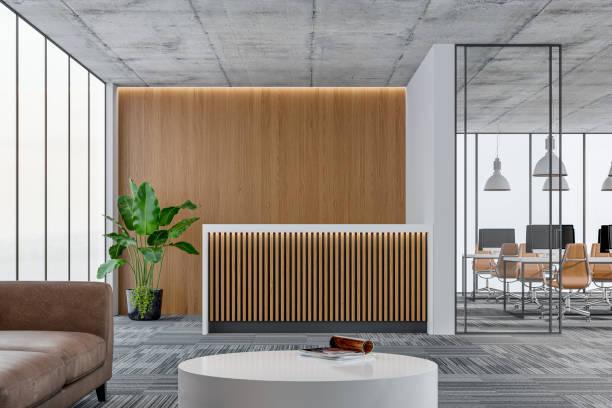Evolution of Reception Table
The reception area is the first point of contact for visitors entering an office space, making the reception tables a crucial element in office design. Beyond its functional role, the reception table serves as a statement piece, reflecting the company's identity and setting the tone for the visitor's experience. In this article, we will explore the significance of the reception table, its design considerations, and the impact it has on creating a welcoming and professional atmosphere.
Functionality and Form
The reception table serves as a multifunctional hub, providing a designated space for various tasks. From a practical standpoint, it is the primary location for administrative tasks such as check-ins, visitor sign-ins, and the distribution of informational materials. Additionally, it often houses essential office equipment, like phones and computers, to facilitate seamless communication between receptionists and other staff members.
While functionality is paramount, the form is equally important. The design of the reception table should align with the overall aesthetic of the office space. A sleek and modern reception table may be suitable for a tech startup, while a more traditional and polished design might be preferred in a law firm. Striking the right balance between functionality and form ensures that the reception table not only serves its practical purpose but also enhances the visual appeal of the reception area.
Branding and Identity
The reception table is an opportunity for companies to express their brand identity and create a lasting impression. It is often the first visual encounter visitors have with the company's image, and as the saying goes, "first impressions matter." The choice of materials, colors, and design elements should align with the company's branding, conveying a consistent message about its values and personality.
Consider a tech company opting for a reception table featuring clean lines, minimalist design, and perhaps incorporating elements of their logo or brand colors. On the other hand, a creative agency might choose a more eclectic and artistic reception table, showcasing the company's innovative spirit. In this way, the reception table becomes a tangible representation of the brand, reinforcing the company's identity in the minds of visitors.
Creating a Welcoming Atmosphere
The reception table plays a pivotal role in shaping the atmosphere of the reception area. Its design and placement influence the overall vibe, contributing to the creation of a welcoming and comfortable environment. The reception area should strike a balance between professionalism and approachability, making visitors feel both valued and at ease.
Consider the layout of the reception table within the space. A centrally positioned table allows for easy visibility and accessibility, creating an open and inviting feel. The use of welcoming elements such as comfortable seating, plants, and ambient lighting around the reception table enhances the overall atmosphere. When visitors feel welcomed, they are more likely to form positive perceptions about the company.
Ergonomics and Accessibility
The design of the reception table should prioritize ergonomics and accessibility. Receptionists spend a significant portion of their day at the table, making it essential to create a workspace that promotes comfort and efficiency. The height of the table, the placement of equipment, and the availability of storage solutions all contribute to the overall ergonomics of the space.
Furthermore, the reception table should be designed with accessibility in mind, ensuring that it complies with disability regulations and is easily accessible to individuals with varying physical abilities. This commitment to inclusivity not only aligns with ethical standards but also enhances the company's reputation as a considerate and forward-thinking organization.
Technology Integration
In the modern era, technology plays a crucial role in office operations, and the reception table is no exception. Integrating technology into the design enhances the efficiency of reception area and contributes to a more streamlined visitor experience. Digital sign-in systems, video conferencing capabilities, and interactive displays are examples of how technology can be seamlessly incorporated into the reception table.
The integration of technology not only improves functionality but also reflects a commitment to innovation. For instance, a high-tech reception table equipped with touchscreen displays may convey a sense of modernity and forward-thinking, particularly for companies in industries driven by technological advancements.
Conclusion
The reception table is more than just a piece of furniture; it is a strategic element in office design that influences the visitor's first impression and sets the tone for their entire experience. From functionality and form to branding and identity, the reception table plays a pivotal role in creating a welcoming atmosphere that aligns with the company's values. As offices continue to evolve, the reception table remains a focal point in shaping the narrative of a company's ethos and professionalism. By carefully considering its design, companies can ensure that their reception area not only serves its practical purpose but also leaves a lasting and positive impression on every visitor.
